7 most unusual funeral rites of the Planet that will surprise
 Bashny.Net
Bashny.Net
Different people have different ideas about the afterlife, and after the death: heaven and hell, a magic land of the dead, reincarnation, etc. But if the different "destinations", it must be different and "delivery methods"... Introducing the seven most unusual ceremonies, which prove that our planet is diverse not only life but also death.
1. China. Floating Coffins
Bo people inhabiting modern Sichuan and Yunnan, disappeared from the map of China centuries ago, does not stand in the fight against the Ming Dynasty. From the brilliant culture bo almost nothing left, just amazing coffins like floating along the steep walls. The age of the ancient burial site of 2,500 years, and the most "fresh" were made 400 years ago. The coffins were made from a single piece of wood and raised on the rocks, setting the caves and crevices, either driven into the rock support. Scholars give several explanations for this unusual burial ritual. According to some, this was done to ensure that no animals or people can not reach them. According to another version, so people tried to ensure bo dead easy transition into another world, as the rocks were regarded as a stairway to heaven.
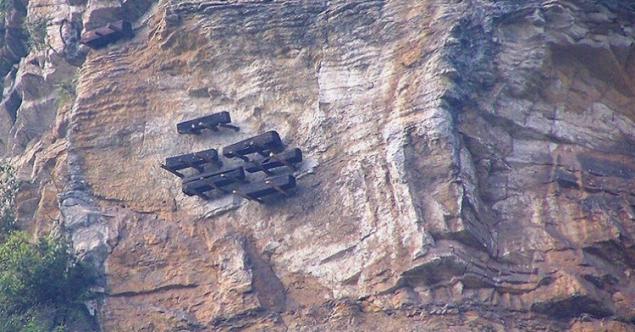

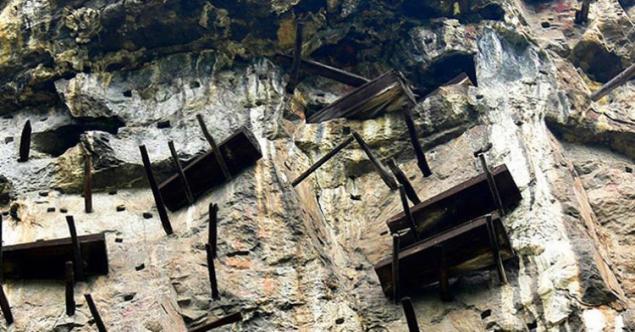
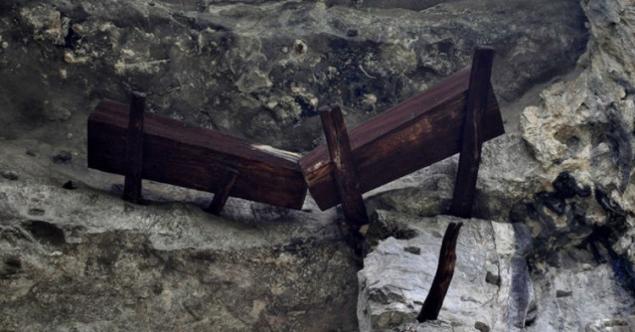
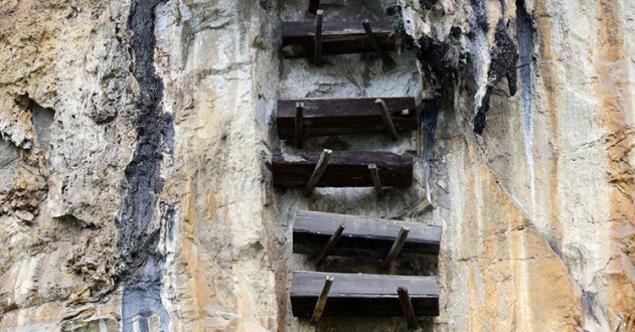
2. South Korea. The beads on memory
Several South Korean companies offered to relatives of deceased persons unusual service: the ashes after the cremation process a very high temperature, it crystallizes and turns into beads, which are then painted in blue and green, pink, purple or black color - on request. Store them usually at home in a beautiful bottle.
I must say that the service, despite the exotic, is popular. And blame the laws and traditions, between which the Koreans were trapped like between Scylla and Charybdis. The fact that Confucianism, the former for centuries the dominant ideology in Korea requires zealous worship of ancestors and the compulsory burial in the ground. At the same time in the twentieth century in the densely populated, but a small area of Korea has matured deficit. And the government began to advocate cremation as a more "compact" way to a funeral. The final point in this set a law passed in 2000, according to which the grave was prepared "validity period" of 60 years, after which relatives should remove it. So now that only three out of ten Koreans are buried in the ground at the old customs and the other waiting for the fate to apply to the ashes, well, or, if you're lucky, in the colored beads.


3. Tibet. Feeding remains vultures
Tibetans believe in the transmigration of souls, the body for them - only the transitory shell, which loses value after death. Cremation or burial in the ground in Tibet maloosuschestvimo - under the feet of the cliff and almost no tree. It is not surprising that here there was such an unusual ritual as "celestial burial" - the feeding of vultures remains. Shocking for a Western man ceremony is held on special areas specially trained people - rogyapami. Gravedigger sharp knife make an incision on the body and leaves it to the birds.
Vultures, according to Tibetans perform two tasks: eat the remains and elevate the soul to heaven. When only the bones remain from the body, rogyapa their fractions, mixed with tsampa (barley flour with yak butter) and again offers the birds. "Heaven's funeral" is still practiced, although environmentalists and physicians have already expressed their displeasure. After eating vultures offer not only the remains of people who died of old age or as a result of the accident, but also from diseases, including such as AIDS and influenza.
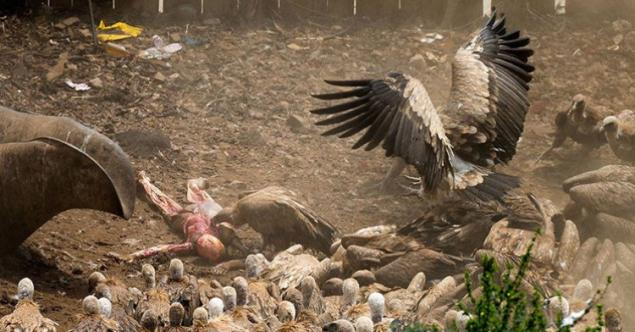
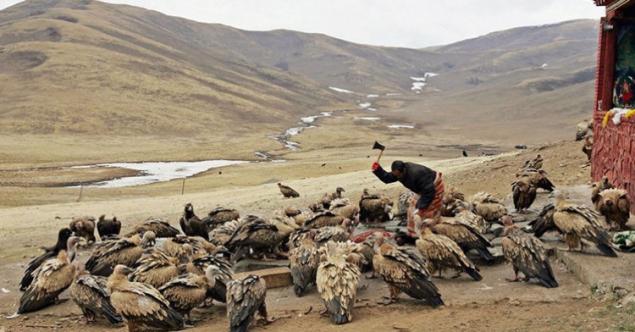

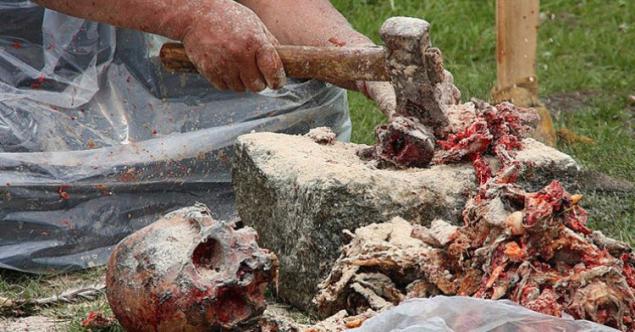
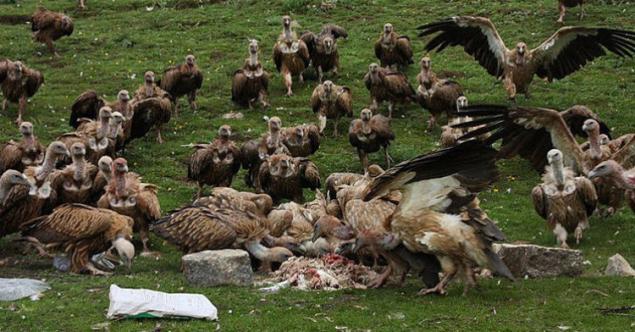
4. Amazonia. Circle of Life
Yanomamo tribe lives in the jungle on the border of Venezuela and Brazil. Inaccessibility of habitats has helped them keep their rituals and customs, sometimes seemingly shocking representatives of Western civilization. So, yanamomo still practice the so-called Endocannibalism - eating dead tribesmen. In fact, a funeral feast - the last stage of the funeral rite. Initially, the body cremated, then the bones are crushed together with ashes put in the pot. Then, usually on the occasion of a celebration of the remains and bananas make a paste, which is eaten by the whole village. The Indians believe that if this ritual is not performed, the soul is forever stuck between the worlds of the living and the world of the dead.

5. Ghana. When the form is set to
In Ghana, the representatives of the people can enjoy hectares for the coffin of the deceased any shape as we order a cake for his birthday. Mercedez-Benz - a successful businessman, bus - for the one who took him in his lifetime, a giant fish - for fisherman, chicken, hen - for the most loving and beloved mother in the world. This tradition appeared in 1950 due to curiosity. The ruler of the country ordered a litter (stretcher as a bed and chairs) in the form of an eagle, but just on the day of delivery died suddenly. Relatives without thinking twice put the body on a stretcher and spectacular in them and buried.
Today workshops undertakers artists have become popular tourist attractions, and their products (reduced dimensions) - welcome guests in private collections, museums and art galleries. Some shops even have a page on Facebook.
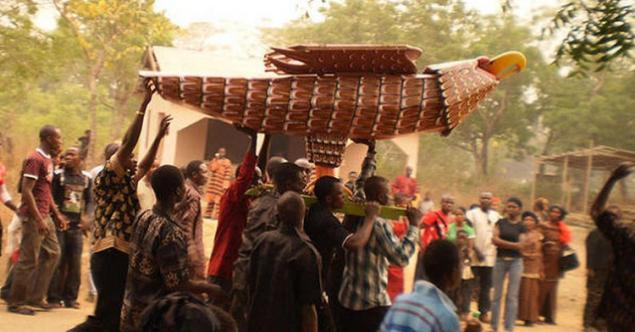
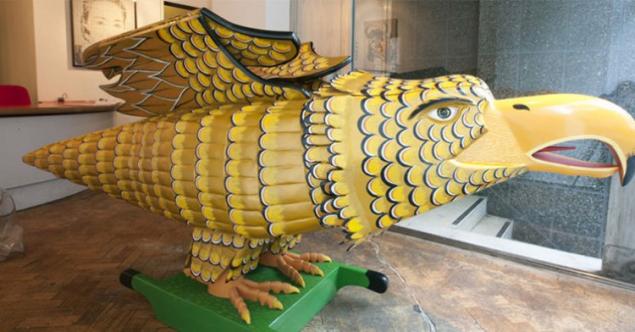

6. Australia. Sophisticated simplicity
In northern Australia, where Aboriginal traditional way of life is preserved best of all, the funeral held in two stages. First, the dead body is placed on a special wooden platform, sheltering leaves and branches and left for a few months. Then, the remaining bones are painted in red ocher. Their fate depends on the beliefs of a particular group of Aboriginal people. Somewhere buried somewhere put to the cave, and the Aborigines Arnhem Land solemnly folded into the bones "tube" from a hollow tree trunk, which is installed in a special place. To produce these unique coffins used eaten by termites trees, so that the master can only handle and paint the surface of the totem signs. Aborigines believe that this ritual helps the soul overcome the perilous path to another world.

7. Bali. Cremation, worthy of kings
Hinduism in Bali is very different from the Indian mainstream. One of these features is the Balinese cremation rite "Ngaba". If funds permit, Ngaba held three days after the death. Otherwise, the body is buried in the ground. There it may remain for months or even years, until the required amount will be collected.
When someone dies, the family continues to treat the deceased as a living, but a sleeping man. On the appointed day the body was placed in a coffin, and those in turn - in a stretcher in the form of the temple (WADA). Wade carried to the cremation ground, the procession passes the most long way, winding through the streets. The Balinese believe that it helps to mislead evil spirits. Already at the funeral pyre of the body is transferred vada in a sarcophagus in the form of a black bull, which burned. After 12 days (or as soon as the relatives will be able to pay for the ceremony) solemnly dispel ashes over the sea or river.
Loading ... Loading ...
Liked? Share with your friends!
Loading ... Loading ...
1. China. Floating Coffins
Bo people inhabiting modern Sichuan and Yunnan, disappeared from the map of China centuries ago, does not stand in the fight against the Ming Dynasty. From the brilliant culture bo almost nothing left, just amazing coffins like floating along the steep walls. The age of the ancient burial site of 2,500 years, and the most "fresh" were made 400 years ago. The coffins were made from a single piece of wood and raised on the rocks, setting the caves and crevices, either driven into the rock support. Scholars give several explanations for this unusual burial ritual. According to some, this was done to ensure that no animals or people can not reach them. According to another version, so people tried to ensure bo dead easy transition into another world, as the rocks were regarded as a stairway to heaven.





2. South Korea. The beads on memory
Several South Korean companies offered to relatives of deceased persons unusual service: the ashes after the cremation process a very high temperature, it crystallizes and turns into beads, which are then painted in blue and green, pink, purple or black color - on request. Store them usually at home in a beautiful bottle.
I must say that the service, despite the exotic, is popular. And blame the laws and traditions, between which the Koreans were trapped like between Scylla and Charybdis. The fact that Confucianism, the former for centuries the dominant ideology in Korea requires zealous worship of ancestors and the compulsory burial in the ground. At the same time in the twentieth century in the densely populated, but a small area of Korea has matured deficit. And the government began to advocate cremation as a more "compact" way to a funeral. The final point in this set a law passed in 2000, according to which the grave was prepared "validity period" of 60 years, after which relatives should remove it. So now that only three out of ten Koreans are buried in the ground at the old customs and the other waiting for the fate to apply to the ashes, well, or, if you're lucky, in the colored beads.


3. Tibet. Feeding remains vultures
Tibetans believe in the transmigration of souls, the body for them - only the transitory shell, which loses value after death. Cremation or burial in the ground in Tibet maloosuschestvimo - under the feet of the cliff and almost no tree. It is not surprising that here there was such an unusual ritual as "celestial burial" - the feeding of vultures remains. Shocking for a Western man ceremony is held on special areas specially trained people - rogyapami. Gravedigger sharp knife make an incision on the body and leaves it to the birds.
Vultures, according to Tibetans perform two tasks: eat the remains and elevate the soul to heaven. When only the bones remain from the body, rogyapa their fractions, mixed with tsampa (barley flour with yak butter) and again offers the birds. "Heaven's funeral" is still practiced, although environmentalists and physicians have already expressed their displeasure. After eating vultures offer not only the remains of people who died of old age or as a result of the accident, but also from diseases, including such as AIDS and influenza.





4. Amazonia. Circle of Life
Yanomamo tribe lives in the jungle on the border of Venezuela and Brazil. Inaccessibility of habitats has helped them keep their rituals and customs, sometimes seemingly shocking representatives of Western civilization. So, yanamomo still practice the so-called Endocannibalism - eating dead tribesmen. In fact, a funeral feast - the last stage of the funeral rite. Initially, the body cremated, then the bones are crushed together with ashes put in the pot. Then, usually on the occasion of a celebration of the remains and bananas make a paste, which is eaten by the whole village. The Indians believe that if this ritual is not performed, the soul is forever stuck between the worlds of the living and the world of the dead.

5. Ghana. When the form is set to
In Ghana, the representatives of the people can enjoy hectares for the coffin of the deceased any shape as we order a cake for his birthday. Mercedez-Benz - a successful businessman, bus - for the one who took him in his lifetime, a giant fish - for fisherman, chicken, hen - for the most loving and beloved mother in the world. This tradition appeared in 1950 due to curiosity. The ruler of the country ordered a litter (stretcher as a bed and chairs) in the form of an eagle, but just on the day of delivery died suddenly. Relatives without thinking twice put the body on a stretcher and spectacular in them and buried.
Today workshops undertakers artists have become popular tourist attractions, and their products (reduced dimensions) - welcome guests in private collections, museums and art galleries. Some shops even have a page on Facebook.



6. Australia. Sophisticated simplicity
In northern Australia, where Aboriginal traditional way of life is preserved best of all, the funeral held in two stages. First, the dead body is placed on a special wooden platform, sheltering leaves and branches and left for a few months. Then, the remaining bones are painted in red ocher. Their fate depends on the beliefs of a particular group of Aboriginal people. Somewhere buried somewhere put to the cave, and the Aborigines Arnhem Land solemnly folded into the bones "tube" from a hollow tree trunk, which is installed in a special place. To produce these unique coffins used eaten by termites trees, so that the master can only handle and paint the surface of the totem signs. Aborigines believe that this ritual helps the soul overcome the perilous path to another world.

7. Bali. Cremation, worthy of kings
Hinduism in Bali is very different from the Indian mainstream. One of these features is the Balinese cremation rite "Ngaba". If funds permit, Ngaba held three days after the death. Otherwise, the body is buried in the ground. There it may remain for months or even years, until the required amount will be collected.
When someone dies, the family continues to treat the deceased as a living, but a sleeping man. On the appointed day the body was placed in a coffin, and those in turn - in a stretcher in the form of the temple (WADA). Wade carried to the cremation ground, the procession passes the most long way, winding through the streets. The Balinese believe that it helps to mislead evil spirits. Already at the funeral pyre of the body is transferred vada in a sarcophagus in the form of a black bull, which burned. After 12 days (or as soon as the relatives will be able to pay for the ceremony) solemnly dispel ashes over the sea or river.
Loading ... Loading ...
Liked? Share with your friends!
Loading ... Loading ...
Tags
See also
3 the most unusual circus world
Top 3 most unusual bath from contemporary designers
The largest butterfly on the planet
The worst places on the planet
The most dangerous places on the planet
How to start a new life: 50 tips that will surprise you
Most unimaginable fillers for ice cream
Origami, which will surprise you (8 photos)
The most unusual places on the planet
16 of the most unusual animals that seem to have arrived from another planet. Unearthly creatures!
















